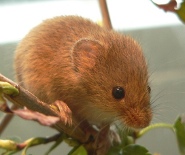 The Eurasian harvest mouse (Micromys minutus) is nature's miniature master of camouflage. Though tiny, it's a slow-moving mouse, and it has many predators, among them owls, foxes, cats, and weasels. When the mouse feels under threat, it adopts a defensive posture by remaining motionless, effectively camouflaging itself against the backdrop of its surroundings.
The Eurasian harvest mouse (Micromys minutus) is nature's miniature master of camouflage. Though tiny, it's a slow-moving mouse, and it has many predators, among them owls, foxes, cats, and weasels. When the mouse feels under threat, it adopts a defensive posture by remaining motionless, effectively camouflaging itself against the backdrop of its surroundings.The Eurasian harvest mouse is widely distributed over Europe and Asia. Since this little mouse is remarkably adaptable and can be found in Great Britain, throughout Russia, and all the way to Japan, it isn't considered endangered. Micromys minutus thrives in many types of habitats, from grasslands and wetlands to bamboo stands. If human development encroaches on its natural habitat, this little mouse can make its home in people's gardens or even in drainage ditches.
An adult Eurasian harvest mouse weighs from 5-9 grams (.176-.316 ounce) and reaches a length anywhere from 50-70 mm (2-2.75 inches). Its body is covered in thick, soft fur, which is buff or reddish-brown in color. The mouse has a naked tail, roughly the same length as its body. The tail is semi-prehensile and allows the mouse to easily climb grass stalks and find seeds to eat.
The Eurasian harvest mouse's diet, like its range and habitat, is varied.
A round-the-clock rodent, the Eurasian harvest mouse is active throughout the day and night on three-hour cycles. It spends half an hour eating, then it sleeps for the remainder of its cycle. In winter, Eurasian harvest mice don't hibernate. They either build nests out of shredded grass or they congregate in barns or grain silos.
The female Eurasian harvest mouse gives birth to her litter in grass nests constructed approximately 100 cm (39 inches) aboveground. Baby mice that are only three days old can already hang onto grass stalks. The lifespan of Micromys minutus in the wild is short. They're lucky to make it to eighteen months old, and many only make it to six months. In captivity, however, these tiny mice have lived to be five years old.
Picture of the Eurasian harvest mouse by Hendrik Osadnik, licensed under GNU Free Documentation License and Creative Commons Attribution-Share Alike 3.0 Unported license.
Keywords: brown , white , tail
The Eurasian harvest mouse, harvest mouse is listed as Near Threatened (LR/nt), is close to qualifying for or is likely to qualify for a threatened category in the near future, on the IUCN Red List of Threatened Species
Namings for the Eurasian harvest mouse
A young / baby of a Eurasian harvest mouse is called a 'pinkie, kitten or pup'. The females are called 'doe' and males 'buck'. A Eurasian harvest mouse group is called a 'nest, colony, harvest, horde or mischief'.Countries
Armenia, Austria, Azerbaijan, Belarus, Belgium, Bosnia and Herzegovina, Bulgaria, China, Croatia, Czech Republic, Denmark, Estonia, Finland, France, Georgia, Germany, Hungary, India, Italy, Japan, Korea, North, Korea, South, Latvia, Lithuania, Macedonia, Mongolia, Netherlands, Poland, Romania, Russia, Serbia and Montenegro, Slovenia, Spain, Sweden, Switzerland, Taiwan, Turkey, Ukraine and United KingdomEurasian harvest mouse habitats
Subarctic forestSome facts about the
Old World harvest mouse
Adult weight : 0.006 kg (0.0132 lbs)
Maximum longevity : 4 years
Female maturity :40 days
Male maturity : 37 days
Gestation : 20 days
Weaning : 18 days
Litter size : 5
Litters per year : 3
Interval between litters : 21 days
Weight at birth : 0.001 kg (0.0022 lbs)
Body mass : 0.008 kg (0.0176 lbs)
Temperature : 37.85 °C (100.13 °F)

Custom Search